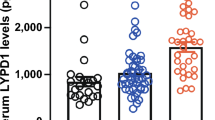Summary
In order to investigate the role of MMP-9 and TIMP-1 in the pathogenesis of systemic sclerosis, the expression of MMP-9 and TIMP-1 was immunohistochemically detected in skin lesions of the patients with diffuse cutaneous systemic sclerosis, skin lesions of the patients with limited cutaneous systemic sclerosis, and skin tissues of normal subjects. The results showed that the expression of MMP-9 in lesions of diffuse cutaneous systemic sclerosis was significantly lower than that of normal skins (P<0.05). However, no significant difference in the level of MMP-9 in the limited cutaneous systemic sclerosis and normal skin was found. Meanwhile, the expression of TIMP-1 in lesions of diffuse cutaneous systemic sclerosis and limited cutaneous systemic sclerosis were significantly higher than that of normal skins (both P<0.05). It was suggested that the expression of MMP-9 and TIMP-1 might play an important role in the development of systemic sclerosis.
Similar content being viewed by others
References
Kim W U, Min S Y, Cho M L et al. Elevated matrix metalloproteinase-9 in patients with systemic sclerosis. Arthritis Res Ther, 2005,7(1):R71–R79
Gerstmeier H, Gabrielli A, Meurer M et al. Levels of type IV collagen and laminin fragments in serum from patients with progressive systemic scleroderma. J Rheumatol,1988, 15:969–972.
Jimenez S A, Feldman G, Bashey R I et al. Co-ordinate increase in the expression of type I and type III collagen genes in progressive systemic sclerosis fibroblasts. Biochem J, 1986, 237(3):837–843
Hulboy D L, Rudolph L A, Matrisian LM. Matrix metalloproteinases as mediators of reproductive function. Mol Hum Reprod, 1997,3(1):27–45
Jackson C J, Nguyen M. Human microvascular endothelial cells differ from macrovascular endothelial cells in their expression of matrix metalloproteinases. Int J Biochem Cell Biol,1997,29(10):1167–1177
Kikuchi K, Kubo M, Hoashi T et al. Decreased MMP-9 activity in the serum of patients with diffuse cutaneous systemic sclerosis. Clin Exp Dermatol, 2002,27(4): 301–305
Giannelli G, Iannone F, Marinosci F et al. The effect of bosentan on matrix metalloproteinase-9 levels in patients with systemic sclerosis-induced pulmonary hypertension. Curr Med Res Opin, 2005,21(3):327–332
Kikuchi K, Kadono T, Furue M et al. Tissue inhibitor of metalloproteinase 1 (TIMP-1) may be an autocrine growth factor in scleroderma fibroblasts. J Invest Dermatol, 1997,108:281–284
Overall CM, Wrata J L, Sodek J. Transcriptional and posttranscriptional regulation of 72 kDa gelatinase/type IV collagenase by transforming growth factor-b1 in human fibroblasts. J Biol Chem, 1991,266:14064–14071
Ihn H. Autocrine TGF-beta signaling in the pathogenesis of systemic sclerosis. J Dermatol Sci,2008,49(2):103–113
Xiao R, Liu F Y, Luo J Y et al. Effect of small interfering RNA on the expression of connective tissue growth factor and type I and III collagen in skin fibroblasts of patients with systemic sclerosis. Br J Dermatol, 2006,155(6): 1145–1153
Verrecchia F, Mauviel A, Farge D. Transforming growth factor-beta signaling through the Smad proteins: role in systemic sclerosis. Autoimmun Rev, 2006,5(8):563–569
Yazawa N, Kikuchi K, Ihn H et al. Serum levels of tissue inhibitor of metalloproteinases 2 in patients with systemic sclerosis. J Am Acad Dermatol, 2000,42:70–75
Young-Min S A, Beeton C, Laughton R et al. Serum TIMP-1, TIMP-2, and MMP-1 in patients with systemic sclerosis, primary Raynaud’s phenomenon, and in normal controls. Ann Rheum Dis, 2001,60(9):846–851
Toubi E, Kessel A, Grushko G et al. The association of serum matrix metalloproteinases and their tissue inhibitor levels with scleroderma disease severity. Clin Exp Rheumatol, 2002,20(2):221–224
Young-Min S A, Beeton C, Laughton R et al. Serum TIMP-1, TIMP-2, and MMP-1 in patients with systemic sclerosis, primary Raynaud’s phenomenon, and in normal controls. Ann Rheum Dis, 2001,60(9):846–851
Author information
Authors and Affiliations
Corresponding author
Additional information
Chi MENG, female, born in 1981, Doctor in Charge
This project was supported by a grant from the Natural Science Fund of Wuhan City.
Rights and permissions
About this article
Cite this article
Meng, C., Chen, X., Li, J. et al. Expression of MMP-9 and TIMP-1 in lesions of systemic sclerosis and its implications. J. Huazhong Univ. Sci. Technol. [Med. Sci.] 28, 480–482 (2008). https://doi.org/10.1007/s11596-008-0424-y
Received:
Published:
Issue Date:
DOI: https://doi.org/10.1007/s11596-008-0424-y




